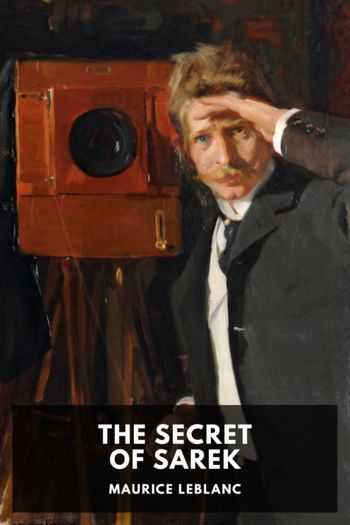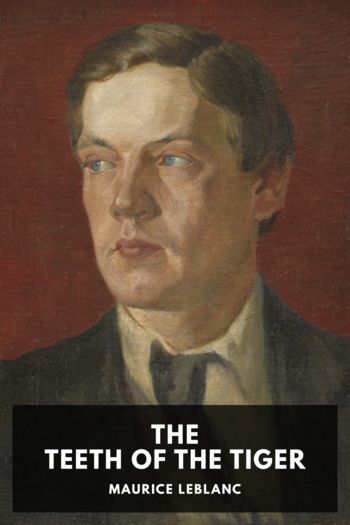The Secret of Sarek, Maurice Leblanc [the ebook reader .txt] 📗

- Author: Maurice Leblanc
Book online «The Secret of Sarek, Maurice Leblanc [the ebook reader .txt] 📗». Author Maurice Leblanc
“How do you account for the resemblance between the crucified woman and myself?”
“I never saw the original, which Maguennoc gave to M. d’Hergemont and which your father kept jealously in his room. But M. d’Hergemont maintained that the resemblance was there. In any case, he accentuated it in his drawing, in spite of himself, remembering all that you had suffered … and through his fault, he said.”
“Perhaps,” murmured Véronique, “he was also thinking of the other prophecy that was once made to Vorski: ‘You will perish by the hand of a friend and your wife will be crucified.’ So I suppose the strange coincidence struck him … and even made him write the initials of my maiden name, ‘V. d’H.’, at the top.” And she added, “And all this happened in accordance with the wording of the inscription. …”
They were both silent. How could they do other than think of that inscription, of the words written ages ago on the pages of the missal and on the stone of the dolmen? If destiny had as yet provided only twenty-seven victims for the thirty coffins of Sarek, were the last three not there, ready to complete the sacrifice, all three imprisoned, all three captive and in the power of the sacrificial murderers? And if, at the top of the knoll, near the Grand Oak, there were as yet but three crosses, would the fourth not soon be prepared, to receive a fourth victim?
“François is a very long time,” said Véronique, presently.
She went to the edge and looked over. The ladder had not moved and was still out of reach.
“The others will soon be coming to my door,” said Stéphane. “I am surprised that they haven’t been yet.”
But they did not wish to confess their mutual anxiety; and Véronique put a further question, in a calm voice:
“And the treasure? The God-Stone?”
“That riddle is hardly less obscure,” said Stéphane, “and also depends entirely on the last line of the inscription: ‘The God-Stone which gives life or death.’ What is this God-Stone? Tradition says that it is a miraculous stone; and, according to M. d’Hergemont, this belief dates back to the remotest periods. People at Sarek have always had faith in the existence of a stone capable of working wonders. In the middle ages they used to bring puny and deformed children and lay them on the stone for days and nights together, after which the children got up strong and healthy. Barren women resorted to this remedy with good results, as did old men, wounded men and all sorts of degenerates. Only it came about that the place of pilgrimage underwent changes, the stone, still according to tradition, having been moved and even, according to some, having disappeared. In the eighteenth century, people venerated the Fairies’ Dolmen and used still sometimes to expose scrofulous children there.”
“But,” said Véronique, “the stone also had harmful properties, for it gave death as well as life?”
“Yes, if you touched it without the knowledge of those whose business it was to guard it and keep it sacred. But in this respect the mystery becomes still more complicated, for there is the question also of a precious stone, a sort of fantastic gem which shoots out flames, burns those who wear it and makes them suffer the tortures of the damned.”
“That’s what happened to Maguennoc, by Honorine’s account,” said Véronique.
“Yes,” replied Stéphane, “but here we are entering upon the present. So far I have been speaking of the fabled past, the two legends, the prophecy and the God-Stone. Maguennoc’s adventure opens up the period of the present day, which for that matter is hardly less obscure than the ancient period. What happened to Maguennoc? We shall probably never know. He had been keeping in the background for a week, gloomy and doing no work, when suddenly he burst into M. d’Hergemont’s study roaring, ‘I’ve touched it! I’m done for! I’ve touched it! … I took it in my hand. … It burnt me like fire, but I wanted to keep it. … Oh, it’s been gnawing into my bones for days! It’s hell, it’s hell!’ And he showed us the palm of his hand. It was all burnt, as though eaten up with cancer. We tried to dress it for him, but he seemed quite mad and kept rambling on, ‘I’m the first victim … the fire will go to my heart. … And after me the others’ turn will come. …’ That same evening, he cut off his hand with a hatchet. And a week later, after infecting the whole island with terror, he went away.”
“Where did he go to?”
“To the village of Le Faouet, on a pilgrimage to the Chapel of St. Barbe, near the place where you found his dead body.”
“Who killed him, do you think?”
“Undoubtedly one of the creatures who used to correspond by means of signs written along the road, one of the creatures who live hidden in the cells and who are pursuing some purpose which I don’t understand.”
“Those who attacked you and François, therefore?”
“Yes; and immediately afterwards, having stolen and put on our clothes, played the parts of François and myself.”
“With what object?”
“To enter the Priory more easily and then, if their attempt failed, to balk enquiry.”
“But haven’t you seen them since they have kept you here?”
“I have seen only a woman, or rather caught a glimpse of her. She comes at night. She brings me food and drink, unties my hands, loosens the fastenings round my legs a little and comes back two hours after.”
“Has she spoken to you?”
“Once only, on the first night, in a low voice, to tell me that, if I called out or uttered a sound or tried to escape, François would pay the penalty.”
“But, when they attacked you, couldn’t you then make out … ?”
“No, I saw no more than François did.”
“And the attack was quite unexpected?”
“Yes, quite. M. d’Hergemont had that





Comments (0)